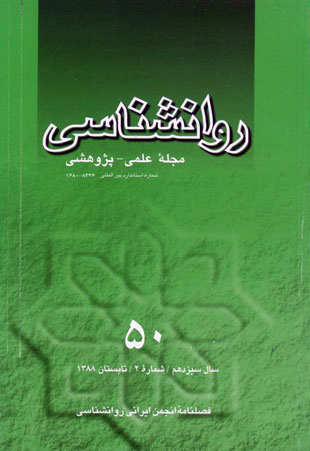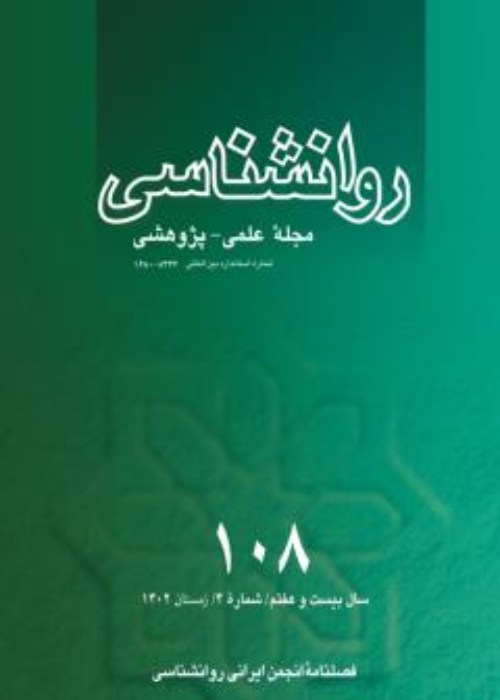فهرست مطالب

فصلنامه روانشناسی
سال سیزدهم شماره 2 (پیاپی 50، تابستان 1388)
- 128 صفحه، بهای روی جلد: 12,500ريال
- تاریخ انتشار: 1388/08/10
- تعداد عناوین: 8
-
-
گزارش و خبرصفحه 239
-
Page 118Through a national research, perception and ideal family structures of parents and their young adult children in 4 different Iranian ethnicities were compared. Three hundred and seventy six families (1128 persons) including father, mother and a young adult child (1529 yearsold) were selected randomly by cluster sampling among families living in Tehran (as the capital and mixed ethnic groups), Isfahan (for Farses), Tabriz (for Torks), Sanandaj (for Kords), and Khoramabad (for Lors) cities. All three members of the families participating in the project completed the Family Adaptability and Cohesion Evaluation Scale-third version (FACES-III, Olson et al. 1985) separately. Results revealed significant differences between percept ion and ideal family structures of the family members in different cities. For instance, while young adult children in Tabriz showed the lowest distance with their parents in the perceived and ideal cohesion and the perceived adaptability scales, they showed the highest distance with their parents in the ideal adaptability scale. Comparison of the family satisfact ion between young adult children and their parents also revealed interesting differences between the five cities; While the young adult sons in Tabriz and Koramabad showed lower satisfaction than one or both of their parents, in Tehran, Isfahan, and Sanandaj, it was the young adult daughters who reported lower family satisfaction than one or both of their parents.Reviewof the observed differences; strongly suggest the proposition that these differences are mostly related to the ethnical characteristics (subcultural values about closeness and togetherness, change, control and gender) of families as well as ecological differences between these cities.Keywords: perceived family structure, ideal family structure, parents, young adult children, FACES, III, ethnicity, Iran
-
Aggression and Anti-Social Behavioral in Adolescents: An Appraisal of Catharsis of Aggression TheoryPage 138One of the theor ies associated with anti-social behaviours to discharging of aggression and energy is Catharsis of Aggression Theory (CAT). The aim of this study was to appraise the validity of CAT in explanation of adolescents’ participation in anti-social behaviours. The research was performed with causal-comparative method. Data were collected from 70 adolescents in two groups: Delinquent adolescents with anti-social behaviours (35) and adolescents with pro-social behaviours (35). The Buss and Perry Aggression Scale (BPAS) was used to evaluate aggression among the subjects. Significant differences were found between the adolescents with anti-social behaviours and pro-social behaviours regarding the aggression specially in terms of the components of aggression: anger and verbal aggression. The mean scores for the adolescents with pro-social behaviours on BPAS was higher than the adolescents with anti-social behaviours. Multiple logistic regression analysis showed that the aggression and control variables explained for %76.4 of the variance in the adolescents’ participation in anti- or pro-social behaviours. The present study disapproved the basic hypothesis of CAT about the adolescents’ participation in anti-social behaviours as a mechanism to discharging of aggression and energy. If Catharsis of Aggression Theory was true, then the adolescents with anti-social behaviours must be more aggressive than the adolescents with pro-social behaviours. Our findings comfirmed the opposite effect. The results of the present study showed that the adolescents with pro-social behaviours were more aggressive than those with anti-social behaviours.Keywords: ant i, social beh aviour, aggression, catharsis theory
-
Page 153Havingmeaning or purpose-in-life (PIL) is one of the characteristics of mental health. Studies have shown that depressed subjects are weak in meaning and PIL. Therefore, it seems necessary that promotion of meaning and PIL be taken into account in their treatment. Cognitive-Humanistic Therapy (CHT) is one of the newapproaches toward depression, which is recently offered by R. Nelson-Jones, but it has not yet been widely investigated. This method of treatment consists of two parts of Life Skills Therapy (LST) and Mental Discipline Therapy (MDT). The purpose of this study was to investigate the effect ofcognitive-humanistic group therapy on the severity of depression symptoms and PIL questionnaire’s scores in female students in Isfahan University. 24 female students were randomly selected among those referring to the Counseling Center of Isfahan University. At the next stage, these students were randomly assigned into two experimental and control groups. Then the BDI and the Crumbaugh & Ma holicks PIL quest io nna ires we re administered as the pre-test for both groups. After that, 10 sessions of group therapy were conducted for the experimental group. Immediately after the last session, and also 15 days later, the same test was administered to both groups as the post-test and the follow-up. The results of the analysis of covariance showed that CHT had significantly decreased the sever ity of de pressive symptoms in the experimental group as compared to the control grou p in the post-test and follow-up phases (p<0.00). The effect of CHT on the PIL scores in the post-test was not sign ificant, but the difference between the two groups was significant in terms of PIL scores in the follow-up phase (p<0.50).Keywords: Cogn it ive, Human ist ic Therapy (CHT), depression, purpose in life
-
Page 170This study was conducted to investigate the relationships among students’goals and their machiavellian personality beliefs. Brandtstadter’s theory of personal goals (1984, 1989, 1999), and machiavellian personality theory (Christie, & Geis, 1970; Sutton, & Keogh, 2001; Andreou, 2004) were used to measure the developmental goals and machiavellian beliefs. Three hundred and fifteen university students (178 girls and 137 boys) were selected by random cluster sampling method. Mean age was 20.1 years and standard deviation was 1.8 years. Two sc a l e s; K id d ie Ma c h Sc a l e a n d Developmental Life Goals Scale, were used. Results indicated that the students pursued six main goals including; social security, esteem, social relation, personal security, avoidance security, and survival goals. The results also showed that there was a complex combination of machiavellian beliefs and personal goals. In general, students view the people as honest and faithful however, th ey b elie ved that it is wise to be manipulative, in some respects, in order to achieve their personal goals. There were also gender differences across the variables. At the end, some recommendations were added.Keywords: Mach iavellian beliefs, developmental goals, Iranian students
-
Page 190The aim of this research was to study the relat ionsh ips between environmental perceptions of family and motivational beliefs with self-regulating learning, by a causal model. A sample of 685 third grade heigher school students in Tehran were selected. All subjects were boys and the samplingmethod was cluster multi-level. The Motivated Strategies for Learning Questionnaire (MSLQ) (Pintrich and DeGroot, 1990), the Students Achievement Goal Orientation (Midgly etal. 1997) and the Perceptions of Parents Scales (POPS) (Grolnick etal. 1997) were administrated on all subjects. The questionnaires validity and reliability were satisfied. The results of Pearson correlation showed that mutual correlation between self-re gulat ing le ar n in g (co gn it ive, metacognitive and resource management), family environmental perceptions (warmth and autonomy support) and motivational beliefs (mastery, approach-performance and avoiding-performance) components were significance. The results of structural equating modeling (SEM) showed that the proposed model was accepted and the fit index was not significant (GFI=0/97, RSMEA=0/048). All path or structural coefficients of purposed model were significant.Keywords: environmental perceptions of family, motivational beliefs, goal orientations, self, efficacy, self, regulating learning
-
Page 206The aim of this study was to survey the validity and reliability of the Substance Abuse Subtle Screening Inventory-3 (SASSI-3). 680 studentsfromthe universities of Tehran and 102 addicted patients of refered to substance abuse treatment centers in Tehran, were included in the study. The results showed opportune reliability and validity for SASSI-3. In this study, internal consistency coefficient (Chronbach’s alpha) for SASSI-3 was obtained as 0.74. This relatively high level of Chronbach’s alpha showes a relatively high level of reliability. Correlation results as between SASSI-3 scalesshowed convergence of SASSI-3 at measurement of single phenomenon. The positive correlation of SASSI-3 a nd AAS sh ow o p po rt un e convergent validity. The difference of t-test scores of students and addicted patients on SASSI-3 and the difference of main effect of group variable on SASSI-3 scales between students and addicted patients according to Mult i-va r ia t e a n alysis of var ia n ce (MANOVA) showed opportune discriminant validity and Az (discriminant index) of 0.97 for SASSI-3 showed opportune diagnostic validity.Keywords: Substance Abuse Subtle Screening Inventory, 3 (SASSI, 3), reliability, validity, students, addiction, Iran
-
Page 225The a im of th is research was to investigate the relation between job design and organ izat ional commitment and performance among managers of big industrial organizations in Isfahan and Tehran. According to the research findings, organizational performance and behavior of the employees have been affected by achievement motivation. So, the relation between variables in this research was investigated by special attention to the moderating role of achievement motivation. The instruments were Organ izat ional Commitment Scale, Job Design Scale, and Achievement Motivation Inventory and Performance Appraisal Measure. Evidence of the instruments validity and reliability was presented. Data were analyzed in two levels of descriptive and inferential statistics by moderating regression. The findings indicated that job design associated with exchange and identification commitment but not with contingency commitment and performance. While including achievement motivation made significant relation between job design and contingency and performance.Keywords: job design, job characteristics, organizational commitment, organizational performance, achievement motivation


